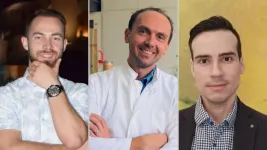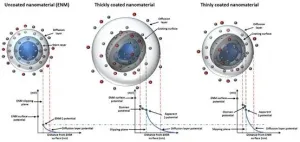Optimizing immunization with Sanaria® PfSPZ-CVac malaria vaccine
2021-06-08
(Press-News.org) ROCKVILLE, MD, USA - June 8, 2021 - The PfSPZ malaria vaccines of Sanaria Inc. are unique in vaccine development as they are composed of weakened (attenuated) forms of the live parasite cells that cause malaria. These parasite cells are called eukaryotic cells and there are no vaccines against any infectious disease composed of such cells. Furthermore, there are no licensed vaccines against any infectious disease caused by a eukaryotic pathogen. Thus, Sanaria and its collaborators have had to take a step by step empirical approach to optimizing immunization with PfSPZ vaccines to achieve a safe, effective, durable, and broadly protective malaria vaccine.
Two recent landmark malaria vaccine studies have moved the optimization process forward and highlighted the strong protective efficacy of Sanaria® PfSPZ-CVac in malaria-naïve adults. In a study published in Nature Communications, 77% (10/13) of subjects vaccinated with a 3-dose regimen administered within a 4 week period were protected 12 weeks later when challenged with live malaria parasites of a strain genetically quite distant (heterologous) from the vaccine strain.
"This high-level efficacy of 3 months would be excellent for protecting travelers to malaria endemic regions against the disease," said Professor Peter Kremsner, Director of the Institute of Tropical Medicine, Travel Medicine and Human Parasitology at the University of Tübingen, Germany who led the study. "We have demonstrated excellent efficacy with just three co-administrations of PfSPZ-CVac and chloroquine, paving the way for a product that can be used for travelers worldwide."
The second study, published in PLoS Pathogen, revealed the profound negative effects of the presence of blood stage malaria parasites on vaccine efficacy. Vaccinations given 7 days apart conferred no protection in study subjects, and this timing coincided with the emergence of parasites into the blood from the liver after previous doses. By changing the timing between doses to 5 days, a regimen first reported in Nature by the Tübingen team, PfSPZ-CVac protective efficacy dramatically increased to 75%. "This study demonstrates the capacity of the malaria parasite to manipulate immune responses of the human host in favor of its own survival and demonstrates how we can optimize the spacing of doses of PfSPZ-CVac to overcome this negative impact," said Dr. Sean Murphy, first author of the paper and Associate Professor at the Department of Laboratory Medicine and Pathology, University of Washington. "Given the high prevalence of malaria infection, these results also have profound implications for malaria vaccine immunization strategies in Africa."
Sanaria® PfSPZ-CVac is a chemo-attenuated, live whole parasite vaccine in which an anti-malarial drug is co-administered with the parasite cells (PfSPZ), to kill parasites. Efficacy in these studies was measured by controlled human malaria infection (CHMI) in which well-characterized, infectious malaria parasites were administered to vaccinated subjects. This is a highly rigorous measure of efficacy because a 100% infective dose of disease-causing parasites is administered and the heterologous challenge strain used in Tübingen is genetically more distant from the vaccine strain than parasites encountered naturally in Africa. Additionally, CHMI is not subject to seasonal variations, subject behaviors, or other unknown variables, as is the case in observational field trials.
INFORMATION:
These studies were sponsored by Sanaria Inc. with support from the German Center for Infection Research (DZIF) at University Hospital, Tübingen, Germany, as well as support from the National Institute of Allergy and Infectious Diseases, NIH, at the Vaccine and Treatment Evaluation Unit at the Kaiser Permanente Washington Health Research Institute.
About Sanaria Inc.: Sanaria is a biotechnology company based in Rockville, Maryland (USA) whose mission is development of whole parasite PfSPZ vaccines to protect against malaria. Sanaria's vaccines have been highly protective against malaria in clinical trials in the US, Africa, and Europe. Sanaria's vaccines will be used to prevent malaria in individuals and in combination with other malaria control measures to stop malaria transmission and eliminate malaria in defined geographic regions.
About the DZIF: The German Center for Infection Research coordinates translational infection research in Germany and provides strategic direction. Its mission is to translate results from basic infectious disease research into clinical research and bring them to patients. Thirty five DZIF research institutions work together against the global threat of infectious diseases. The Tübingen site coordinates research on malaria under the guidance of the Director and site spokesperson Prof. Peter Kremsner.
About the Department of Laboratory Medicine and Pathology, University of Washington: The Department of Laboratory Medicine and Pathology provides biomedical clinical care, education, and research and is internationally recognized as a center for clinical and basic science research. Dr. Sean Murphy serves in the Department's Division of Microbiology and his research program is focused on malaria vaccine development, diagnostics, and clinical trials.
About the Kaiser Permanente Washington Health Research Institute: The Kaiser Permanente Washington Health Research Institute brings together a faculty of investigators, research associates, and biostatisticians with broad expertise in medicine, biostatistics, and other relevant disciplines. Over the past five years, Dr. Lisa Jackson and the Institute have joined forces with other Seattle area institutions to perform several CHMI studies to accelerate malaria vaccine developmen
ELSE PRESS RELEASES FROM THIS DATE:
2021-06-08
Financing a sustainable global ocean economy may require a Paris Agreement type effort, according to a new report from an international team of researchers led by the University of British Columbia.
That's because a significant increase in sustainable ocean finance will be required to ensure a sustainable ocean economy that benefits society and businesses in both developing and developed countries.
The report, published today - on World Ocean Day - identifies major barriers to financing such a sustainable ocean economy. This includes all ocean-based industries, like seafood production, shipping and renewable energy, and ecosystem goods and services, ...
2021-06-08
Monarch butterflies raised indoors still know how to fly south if given enough time to orient themselves, according to new University of Guelph research.
The finding is good news for the many nature lovers and school students who raise monarchs and then set them free to help boost struggling numbers.
Monarchs are the only butterfly known to make a long-distance migration to warmer wintering grounds. While those born in the spring and early summer live only from two to six weeks, those that emerge in the late summer sense environmental signals that tell them to fly thousands of kilometres south, to central Mexico.
Recent ...
2021-06-08
Ever since the world's first ever microscope was invented in 1590 by Hans and Zacharias Janssen --a Dutch father and son-- our curiosity for what goes on at the tiniest scales has led to development of increasingly powerful devices. Fast forward to 2021, we not only have optical microscopy methods that allow us to see tiny particles in higher resolution than ever before, we also have non-optical techniques, such as scanning force microscopes, with which researchers can construct detailed maps of a range of physical and chemical properties. IBEC's Nanoscale bioelectrical characterization group, led by UB Professor Gabriel Gomila, in collaboration with members of the IBEC's Nanoscopy for nanomedicine group, have been ...
2021-06-08
Age-related macular degeneration (AMD) is the most common cause of vision loss in people over 50. Up to 12 percent of those over 80 have the chronic disease. An estimated 16.4 million adults are affected by retinal vein occlusion (RVO) worldwide, a condition caused by a thrombosis of a retinal vein. It is the second most common cause of blindness from retinal vascular disease after diabetic retinopathy (DR). DR in turn is the leading cause of blindness in developed countries and affects up to 80 percent of people with more than 20 years of diabetes. It can lead ...
2021-06-08
A defining characteristic of all life is its ability to evolve. However, the fact that biologically engineered systems will evolve when used has, to date, mostly been ignored. This has resulted in biotechnologies with a limited functional shelf-life that fail to make use of the powerful evolutionary capabilities inherent to all biology.
Sim Castle, first author of the research, published in Nature Communications, and a PhD student in the School of Biological Sciences at Bristol, explained the motivation for the work: "The thing that has always fascinated me about biology is that it changes, it is chaotic, it adapts, it evolves. Bioengineers therefore do not just design static artefacts - they design living populations that ...
2021-06-08
The presence of amino acids on the prebiotic Earth is widely accepted, either coming from endogenous chemical processes or being delivered by extraterrestrial material. On the other hand, plausibly prebiotic pathways to peptides often rely on different aqueous approaches where condensation of amino acids is thermodynamically unfavorable. Now, chemists from the Ruđer Bošković Institute (RBI), in collaboration with colleagues from Xellia Pharmaceuticals, have shown that solid-state mechanochemical activation of glycine and alanine in combination with mineral surfaces leads to the formation of peptides. ...
2021-06-08
A team of astronomers using the Atacama Large Millimeter/submillimeter Array (ALMA) has completed the first census of molecular clouds in the nearby Universe, revealing that contrary to previous scientific opinion, these stellar nurseries do not all look and act the same. In fact, they're as diverse as the people, homes, neighborhoods, and regions that make up our own world.
Stars are formed out of clouds of dust and gas called molecular clouds, or stellar nurseries. Each stellar nursery in the Universe can form thousands or even tens of thousands of new stars during its lifetime. Between 2013 and 2019, astronomers on the PHANGS-- Physics at High Angular Resolution in Nearby GalaxieS-- project conducted the first systematic survey of 100,000 stellar nurseries ...
2021-06-08
COLUMBUS, Ohio - Astronomers have taken a big step forward in understanding the dark and violent places where stars are born.
Over the past five years, an international team of researchers has conducted the first systematic survey of "stellar nurseries" across our part of the universe, charting the more than 100,000 of these nurseries across more than 90 nearby galaxies and providing new insights into the origins of stars.
"Every star in the sky, including our own sun, was born in one of these stellar nurseries," said Adam Leroy, associate professor of astronomy at The Ohio State University and one of ...
2021-06-08
Researchers from the University of Arizona will present findings from radio-astronomical observations of organic molecules at the 238th Meeting of the American Astronomical Society, or AAS, during a press conference titled "Molecules in Strange Places" at the 238th AAS Meeting on Tuesday, June 8, at 12:15 p.m. EDT.
A team led by Lucy Ziurys at the University of Arizona reports observations of organic molecules in planetary nebulae in unprecedented detail and spatial resolution. Using the Atacama Large Millimeter Array, or ALMA, Ziurys and her team observed radio emissions from hydrogen cyanide (HCN), formyl ion (HCO+) and carbon monoxide (CO) in five planetary nebulae: M2-48, M1-7, M3-28, K3-45 and K3-58.
The ...
2021-06-08
Researchers have developed a 'library of properties' to help identify the environmental impact of nanomaterials faster and more cost effectively.
Whilst nanomaterials have benefited a wide range of industries and revolutionised everyday life, there are concerns over potential adverse effects - including toxic effects following accumulation in different organs and indirect effects from transport of co-pollutants.
The European Union H2020-funded NanoSolveIT project is developing a ground-breaking computer-based Integrated Approach to Testing and Assessment (IATA) for the environmental health and safety of nanomaterials.
Over ...
LAST 30 PRESS RELEASES:
[Press-News.org] Optimizing immunization with Sanaria® PfSPZ-CVac malaria vaccine







